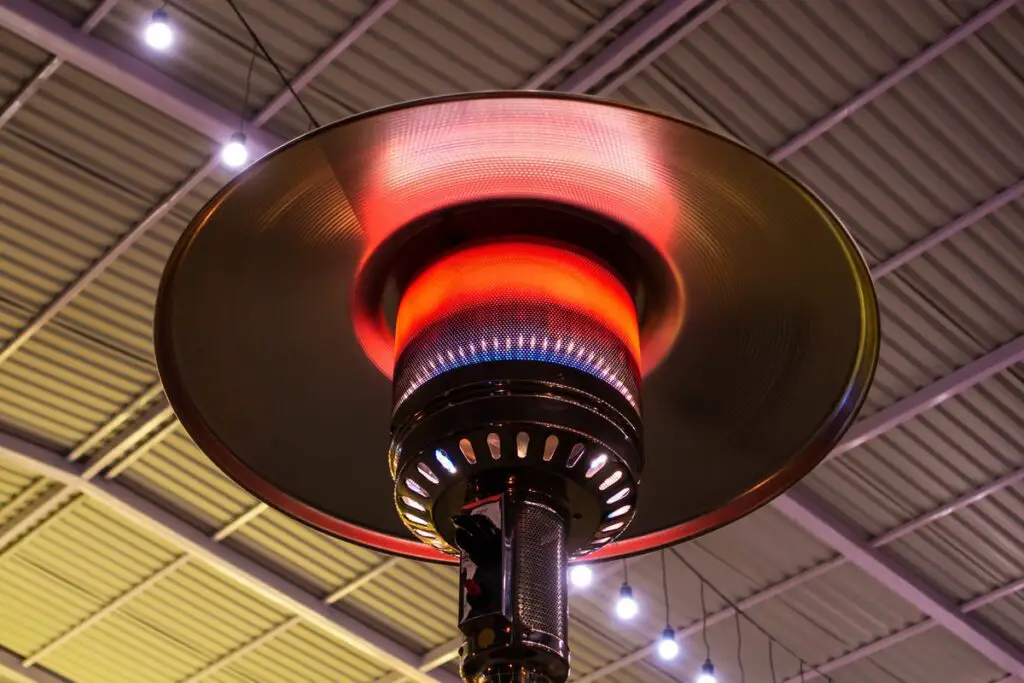In most cases, patio heaters and water do not mix.
A patio heater can be weatherproof, but this does not mean water cannot damage it.
Owners can, however, choose to apply a waterproof covering to their patio heater to protect it from potential water damage.
Patio heaters can be a welcomed addition to any wintry household, allowing residents to once again enjoy their porches, yards, and patios without freezing solid.
But when heat meets snow or ice, the typical result is a puddle of cold water. This begs the question: Can patio heaters and water coexist?
This article will examine patio heaters and their different design types, power sources, and waterproofing features to determine how patio heaters and water can exist together.

Patio Heaters and Water: What Are They?
Patio heaters are devices that generate heat in outdoor areas. In most cases, patio heaters and water do not go together well.
The function of a patio heater is to produce heat using various forms of fuel.
Most heaters will give trouble lighting from electric to gas and remain lit if exposed to heavy rain.
They can be tall, gas-powered machines capable of heating over fifty square feet or squat, electrically powered heaters that heat a few square feet of space.
Still, regardless of their design, heating capacity, or fuel source, all patio heaters have a primary purpose—to provide heat to an outdoor patio or porch area during cold weather.
However, the ideal type of patio heater depends on a homeowner’s needs and preferences.
Are There Different Types of Patio Heaters?
There are several different types of patio heaters. Some are convenient for large outdoor spaces, while others are better suited to smaller patios and yards.
The best one for your home depends on several factors, including a budget, preference, and heating needs.
The most common types of patio heaters are:
- Standing
- Tabletop
- Hanging
- Mounted
Standing patio heaters are the most effective at keeping large areas warm, and tabletop and hanging models generate the most negligible heat.
However, it’s best to choose a patio heater that meets the size of your yard rather than looking for the model that generates the most significant amount of heat.
When patio heaters and water mix, standing models can be more susceptible to damage.
Standing
Some standing patio heaters tend to have a slight streetlamp or umbrella-like appearance. Others may be pyramidal or columnar with a protective metal covering.
The average height of a standing patio heater is about seven feet, and the average weight is approximately 50 lbs.
These tall patio heaters can warm up between 10 and 100 square feet of space, and the exact capacity varies from model to model.
Fortunately, the price for a standing patio heater is pretty consistent, no matter its heating capacity or height.
Most shoppers can find a quality standing heater for between $100 and $300.
Individuals living in apartments, townhomes, or tiny homes may want to choose an alternative patio heater due to space restrictions.
Fortunately, tabletop patio heaters are a perfectly acceptable alternative.
Tabletop
Though tabletop patio heaters are far less standard than standing or hanging models, they can provide the ideal amount of heat to smaller patio areas, reducing wasted heat and helping to maximize available space.
Most tabletop patio heaters weigh about 20 lbs or less, can provide up to 50 square feet of warmth, and are easy to light.
Considering how lightweight and practical these heaters are, they can be an excellent choice for those with multiple patio seating areas.
Being lightweight, you can quickly move them should there be a potential for your patio heaters and water to connect with pending rain.
The downside of being lightweight and portable is that you’re also easy to knock down, which can prove dangerous when heat, fire, or ignited gas is involved.
In these instances, a hanging patio heater might work well.
Hanging
Hanging patio heaters require a ceiling connection, but the payoff is 100+ square feet of warmth.
These heaters consume zero floor space and are fantastically easy to install.
Being hung from a ceiling already protects your patio heaters and water mixing during a rain storm.
Still, they may consume excessive energy while heating your patio. That’s because hot air rises.
If you place a hanging heater, much of the air it warms will rise above it, failing to provide much heat to objects or people below.
Consequently, hanging patio heaters tend to work harder than other types.
A mounted heater might be a worthwhile alternative to hanging models and is excellent for undercover.
Related Reading: Stay Warm with a Heater Under a Covered Patio: Your Ultimate Guide
Mounted
Wall-mounted patio heaters can heat vast areas and consume a relatively low energy.
However, they can pose a danger to those unaware of their presence, and they should be placed high enough along a wall to prevent accidents involving children or pets.
The most significant disadvantage of these handy heaters is the price.
On average, wall-mounted models cost about $100 more than comparable standing patio heaters.
How Are Patio Heaters Powered?
There are three primary fuel sources for patio heaters:
- Electric
- Gas
- Wood
The type of fuel source can influence the heater’s waterproofness.
For example, electric patio heaters can quickly malfunction after contacting moisture. They can also become hazardous if plugged into an outlet while wet.
On the other hand, wood-fueled patio heaters can withstand rain and snow without falling.
However, they pose a greater risk of stopping heating simply because they rely on burning wood or active flames to generate heat.
Consequently, each fuel source can be beneficial or a hindrance.
The best type of fuel for your home’s patio heater depends on your preferences.
If you set up protection for your outdoor electrical appliances in wet weather, an electric heater might be a great choice.
Still, a covered, propane-fueled heater might withstand rain better without a higher fire risk.
By weighing the following information, you’ll understand better how patio heaters can (and occasionally cannot) be waterproof.
Related Reading: What to Know About Outdoor Patio Heaters
Electricity
Electric patio heaters can be incredibly convenient. They’re easy to operate, require virtually zero cleaning, and can heat reasonably sized spaces.
Patio gas heaters require more cleaning as they contain smaller pieces vital to functioning.
However, they are prone to weather damage like rain, so many models come with waterproof covers.
Standing models, in particular, require this protection to survive rainy or snowy weather. That’s because they can be challenging to lift and carry indoors whenever evil weather strikes.
Additionally, it’s essential to unplug electric patio heaters before wet weather arrives.
Otherwise, you may be putting yourself and your household at risk of electrocution.
In some ways, gas-powered patio heaters can be a little more water-resistant, but they’re also not waterproof.
Gas
Gas or propane-powered patio heaters often have a large enclosed chamber that houses the fuel.
In this way, they can be a little more complicated and water-resistant than electric or wood-burning heaters, but they come with safety precautions.
However, water exposure can still corrode metal components and exteriors, dramatically shortening product life.
Wood
Wood-burning patio heaters are fairly rare, as they often rely on fire to generate heat.
A few models use charcoal as a heat source, but wood-burning cast-iron stoves and patio heaters are slightly more common.
These patio heaters require constant attention and should never be left unattended.
There’s also some evidence that wood-burning heaters negatively impact the surrounding environment and human health, so those with sensitive respiratory systems may benefit from choosing a heater with a different fuel type.

Patio heaters lit by flames can also sputter out in rainy or snowy weather.
Significant moisture can cause these heaters to rust and degrade, much like gas-powered models.
However, wood-burning heaters are built to withstand extreme conditions so that they may last longer than their gas-filled equivalents.
Conclusion
Patio heaters are often water or weather-resistant, but that doesn’t mean they’re waterproof.
Many standing patio heaters require waterproof covers to remain safe during wet weather, and tabletop models are portable enough to take shelter indoors during thunderstorms.
Wall-mounted models require specifically designed waterproof covers to stay protected, and hanging patio heaters can either be covered or briefly removed.
These protective measures are necessary for all patio heaters, regardless of fuel type.
Enjoy living the outdoor life!!!
